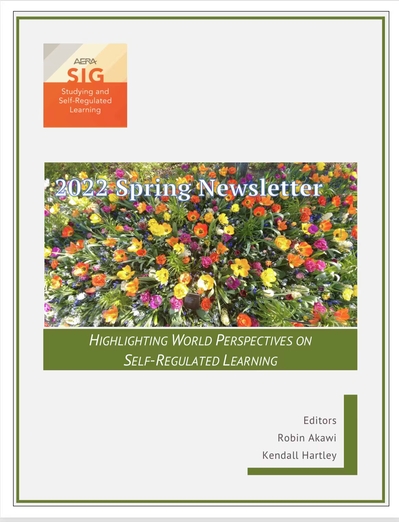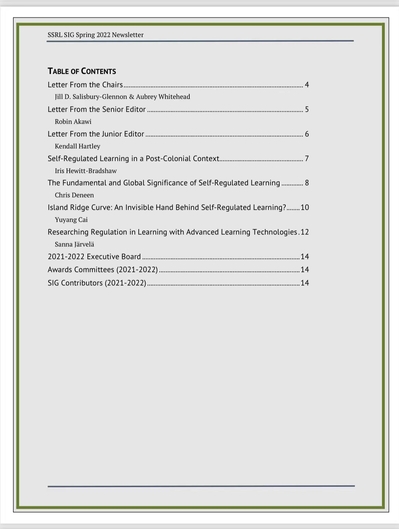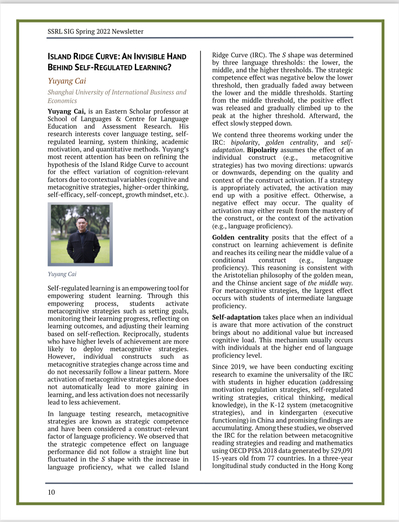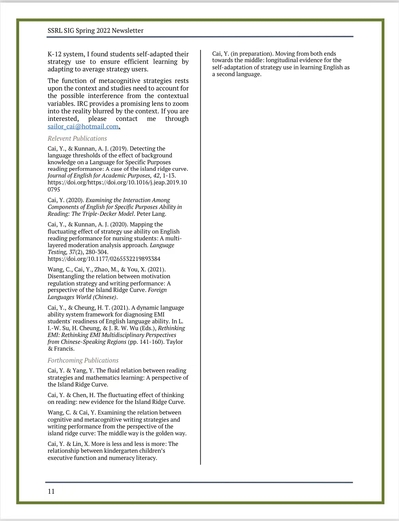近日,我校蔡雨陽教授接到國際頂級教育學術組織美國教育學會(AERA)邀請,在其旗下的學術簡報SSRL SIG Newsletter撰文介紹其原創的“島脊曲線理論”,作為2022 年春季刊的焦點研究向全球自主學習研究領域重點推介。
美國教育學會(The American Educational Research Association)成立于1916年,是國際教育學術界最頂級的學術組織(詳見https://www.aera.net/About-AERA),其宗旨是通過鼓勵教育與評價相關的學術研究,優化教育過程,提升教育質量。現有來自世界96個國家的25000多名成員,研究領域涵蓋心理學、統計學、社會學、歷史學、經濟學、哲學、人類學、政治科學等領域。
學習與自主學習興趣組(Studying and Self-Regulated Learning Special Interest Group;SSRL SIG)是美國教育學會的一個分支組織,成立于1986年(https://ssrlsig.org/)。其成員為來自各國自主學習領域學者,包括眾多自主學習領域的殿堂級學者,如Patricia A. Alexander,Albert Bandura,Steve Graham,Nancy E. Perry, Dale Schunk,Philip H. Winne,Barry J. Zimmerman。(詳見https://ssrlsig.org/resources/pillars-of-ssrl/major-researchers-in-ssrl/)。
SSRL SIG 主辦的學術簡報(SSRL SIG Newsletter)每年出版三期,由簡報編輯部選定近幾年自主學習領域最具研究潛力的主題,在全世界范圍向最具代表性的研究者約稿。
蔡雨陽教授2014年獲香港大學語言測評哲學博士學位,2018年被評為上海市高層次特聘教授,2019年9月入職我校。現任國際商務外語學院教授、校語言教育與測評研究中心主任、校領軍人才。
蔡教授的主要研究領域包括語言測評、教育心理學以及教育測量與統計,提出了語言測評理論“動態語言能力系統 DLAS”和教育心理學理論“島脊曲線理論IRC”,開發了統計模型多層調節分析模型MLMA。同時,蔡教授具有豐富的語言測試開發經歷,是全國醫護英語考試METS的主要開發者和香港《新語言水平測試》開發團隊的核心成員,曾任英國、美國以及國內多家語言測評機構顧問。現任Educational Psychology, Educational Studies等多家SSCI期刊編委,Applied Linguistics, Language Testing, Language Assessment Quarterly等十余家SSCI期刊匿名評審。
附:SSRL SIG Newsletter刊發的文章內容簡介




島脊曲線:自主學習背后的隱形之手?
語言能力的形成過程不僅是語言知識的積累過程,語言學習者個體要素如學習策略、內容知識、思維能力、學習動機等因素對語言能力的成長也起著至關重要的作用。最新的語言教育研究卻發現,這些要素對語言學習的作用在不同語言學習者身上的體現各不相同。蔡雨陽教授的最新研究發現,某些特定的語言學習者要素(如策略能力、內容知識、評判思維能力、系統思維能力、動機調節能力、成長思維、自我效能、自我信心等)在不同語言學習者身上呈現出斜置S型波動的規律,并把這種現象稱為“島脊曲線”(Island Ridge Curve)。最近兩年,蔡教授和他的團隊將島脊曲線模型逐步拓展為一套完整的教育心理學理論體系。該理論不僅適用于語言教育,而且適用于從幼兒園到博士的不同教育階段,涵蓋第一語言教育、第二語言教育、數學和科學教育等人類智能發展的所有教育領域。迄今為止,島脊曲線理論的效度得到77個國家60多萬人的實證數據驗證。島脊曲線理論對語言教育和其他學科教育的重要意義在于,教育過程應該對不同學習者個性化的學習潛能進行診斷,發現不同能力發展階段不同學習者的個性化需求,然后有針對性地進行“因材施教”,從而提升教育效率。
成果原文:
Island Ridge Curve: An invisible hand behind self-regulated learning?
Yuyang Cai
Shanghai University of International Business and Economics
Self-regulated learning is an empowering tool for empowering student learning. Through this empowering process, students activate metacognitive strategies such as setting goals, monitoring their learning progress, reflecting on learning outcomes, and adjusting their learning based on self-reflection. Reciprocally, students who have higher levels of achievement are more likely to deploy metacognitive strategies. However, individual constructs such as metacognitive strategies change across time and do not necessarily follow a linear pattern. More activation of metacognitive strategies alone does not automatically lead to more gaining in learning, and less activation does not necessarily lead to less achievement.
In language testing research, metacognitive strategies are known as strategic competence and have been considered a construct-relevant factor of language proficiency. We observed that the strategic competence effect on language performance did not follow a straight line but fluctuated in the S shape with the increase in language proficiency, what we called Island Ridge Curve (IRC). The S shape was determined by three language thresholds: the lower, the middle, and the higher thresholds. The strategic competence effect was negative below the lower threshold, then gradually faded away between the lower and the middle thresholds. Starting from the middle threshold, the positive effect was released and gradually climbed up to the peak at the higher threshold. Afterward, the effect slowly stepped down.
We contend three theorems working under the IRC: bipolarity, golden centrality, and self-adaptation. Bipolarity assumes the effect of an individual construct (e.g., metacognitive strategies) has two moving directions: upwards or downwards, depending on the quality and context of the construct activation. If a strategy is appropriately activated, the activation may end up with a positive effect. Otherwise, a negative effect may occur. The quality of activation may either result from the mastery of the construct, or the context of the activation (e.g., language proficiency).
Golden centrality posits that the effect of a construct on learning achievement is definite and reaches its ceiling near the middle value of a conditional construct (e.g., language proficiency). This reasoning is consistent with the Aristotelian philosophy of the golden mean, and the Chinse ancient sage of the middle way. For metacognitive strategies, the largest effect occurs with students of intermediate language proficiency.
Self-adaptation takes place when an individual is aware that more activation of the construct brings about no additional value but increased cognitive load. This mechanism usually occurs with individuals at the higher end of language proficiency level.
Since 2019, we have been conducting exciting research to examine the universality of the IRC with students in higher education (addressing motivation regulation strategies, self-regulated writing strategies, critical thinking, medical knowledge), in the K-12 system (metacognitive strategies), and in kindergarten (executive functioning) in China and promising findings are accumulating. Among these studies, we observed the IRC for the relation between metacognitive reading strategies and reading and mathematics using OECD PISA 2018 data generated by 529,091 15-years old from 77 countries. In a three-year longitudinal study conducted in the Hong Kong K-12 system, I found students self-adapted their strategy use to ensure efficient learning by adapting to average strategy users.
The function of metacognitive strategies rests upon the context and studies need to account for the possible interference from the contextual variables. IRC provides a promising lens to zoom into the reality blurred by the context. If you are interested, please contact me through sailor_cai@hotmail.com
Relevant Publications
Cai, Y., & Kunnan, A. J. (2019). Detecting the language thresholds of the effect of background knowledge on a Language for Specific Purposes reading performance: A case of the island ridge curve. Journal of English for Academic Purposes, 42, 1-13. https://doi.org/https://doi.org/10.1016/j.jeap.2019.10 0795
Cai, Y. (2020). Examining the Interaction Among Components of English for Specific Purposes Ability in Reading: The Triple-Decker Model. Peter Lang.
Cai, Y., & Kunnan, A. J. (2020). Mapping the fluctuating effect of strategy use ability on English reading performance for nursing students: A multi-layered moderation analysis approach. Language Testing, 37(2), 280-304. https://doi.org/10.1177/0265532219893384
Wang, C., Cai, Y., Zhao, M., & You, X. (2021). Disentangling the relation between motivation regulation strategy and writing performance: A perspective of the Island Ridge Curve. Foreign Languages World (Chinese).
Cai, Y., & Cheung, H. T. (2021). A dynamic language ability system framework for diagnosing EMI students' readiness of English language ability. In L. I.-W. Su, H. Cheung, & J. R. W. Wu (Eds.), Rethinking EMI: Rethinking EMI Multidisciplinary Perspectives from Chinese-Speaking Regions (pp. 141-160). Taylor & Francis.
Forthcoming Publications
Cai, Y. & Yang, Y. The fluid relation between reading strategies and mathematics learning: A perspective of the Island Ridge Curve.
Cai, Y. & Chen, H. The fluctuating effect of thinking on reading: new evidence for the Island Ridge Curve.
Wang, C. & Cai, Y. Examining the relation between cognitive and metacognitive writing strategies and writing performance from the perspective of the island ridge curve: The middle way is the golden way.
Cai, Y. & Lin, X. More is less and less is more: The relationship between kindergarten children’s executive function and numeracy literacy.
Cai, Y. Moving from both ends towards the middle: longitudinal evidence for the self-adaptation of strategy use in learning English as a second language.
